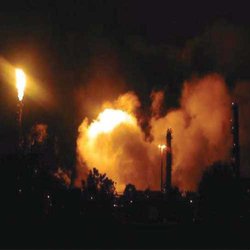Louisiana environmental racism case gets international hearing
 For the first time in history, an international human rights body has agreed to review a case involving allegations of environmental racism in the United States.
For the first time in history, an international human rights body has agreed to review a case involving allegations of environmental racism in the United States.The Inter-American Commission on Human Rights (IACHR) will hear a complaint filed by the New Orleans-based Advocates for Environmental Human Rights (AEHR) on behalf of the people of Mossville, La. An autonomous body of the Organization of American States, the IACHR along with the Inter-American Court of Human Rights comprise the inter-American system for promoting and protecting human rights.
Scheduled to take place some time in the next three months, the review will consider whether the U.S. government has violated the predominantly African-American community's residents' human rights to life, health, equality, freedom from racial discrimination, and "privacy as it relates to the inviolability of the home" by allowing numerous industrial facilities to locate there and emit millions of pounds of highly toxic chemicals every year.
"I am grateful that the Commission decided to take our human rights case," said petitioner Dorothy Felix, who serves as the volunteer vice president of Mossville Environmental Action Now. "We believe that environmental protection should not be based on the color of our skin."
Located near Lake Charles in southwestern Louisiana's Calcasieu Parish, the unincorporated rural community of Mossville is surrounded by 14 industrial facilities that each year spew more than 4 million pounds of highly toxic chemicals to the environment. The pollution includes known carcinogens including dioxin, polycyclic aromatic hydrocarbons, solvents like xylene and toluene, and heavy metals such as lead and mercury.
Mossville was featured in the 2002 documentary film "Blue Vinyl," which explores the negative health impacts of polyvinyl chloride production. The area has the largest concentration of vinyl plastic manufacturers in the U.S., as well as a coal-fired power plant, oil refineries and chemical production facilities.
Serious health impacts from the pollution have been documented among Mossville residents by the University of Texas at Galveston Medical Branch and the U.S. Agency for Toxic Substances and Disease Registry. A 2007 study showed that the types of dioxin compounds found in the blood of Mossville residents are the same types emitted by the industrial facilities. Dioxins are among the most toxic chemicals known to science.
In the late 1990s, Mossville area residents began collecting air samples that revealed violations of state standards for pollutants including vinyl chloride and benzene. The Environmental Protection Agency later confirmed violations, fining some facilities. The effort spread to communities throughout Louisiana's so-called "Cancer Alley" and led to the formation of the Louisiana Bucket Brigade, a grassroots pollution monitoring project.
The petition [pdf] to IACHR from Mossville residents alleges that the U.S. government and local political subdivisions ignored their obligation to protect human rights by allowing all of these polluting industries to build and operate near Mossville.
In its response [pdf], the U.S. government asserts that the IACHR "does not have authority to request that the United States adopt precautionary measures" to prevent communities from being treated like Mossville because such an action is based on commission rules that were not formally approved by the individual countries that belong to the OAS. It also accuses the petitioners of an "extraordinarily and erroneously expansive interpretation" of U.S. treaty obligations -- claims the petitioners reject.
"Our government is a member of the OAS and has also ratified the International Convention on the Elimination of All Forms of Racial Discrimination and the International Covenant on Civil and Political Rights, which create clear obligations to protect our human right to freedom from racial discrimination whether it is intentional or the result of a policy or action," said attorney Nathalie Walker, AEHR's co-director. "However, these obligations are rarely acknowledged by our government, much less upheld."
Monique Harden, AEHR's other co-director, noted that Mossville is one of a number of communities of color across the U.S. that are disproportionately burdened with toxic pollution as a result of government decisions.
"The good news is that a judicial review by the Inter-American Commission on Human Rights can open the door to ending the pattern of environmental racism by introducing a human rights framework for environmental protection," she said.
The issue of environmental injustice in the U.S. South has been in the spotlight in recent months. Last October, environmental justice leaders representing more than a dozen polluted communities from six Southern states met with Environmental Protection Agency leaders and asked them to take action to better protect the health of the region's low-income communities and communities of color.
That meeting came after environmental justice leaders urged the EPA to address historic problems in its Region 4 office covering eight states in the Deep South, with its legacy of racism and unequal environmental protection.
(Photo of toxic pollution in Mossville, La. from Mossville Environmental Action Now's Facebook fan page.)
Tags
Sue Sturgis
Sue is the former editorial director of Facing South and the Institute for Southern Studies.
